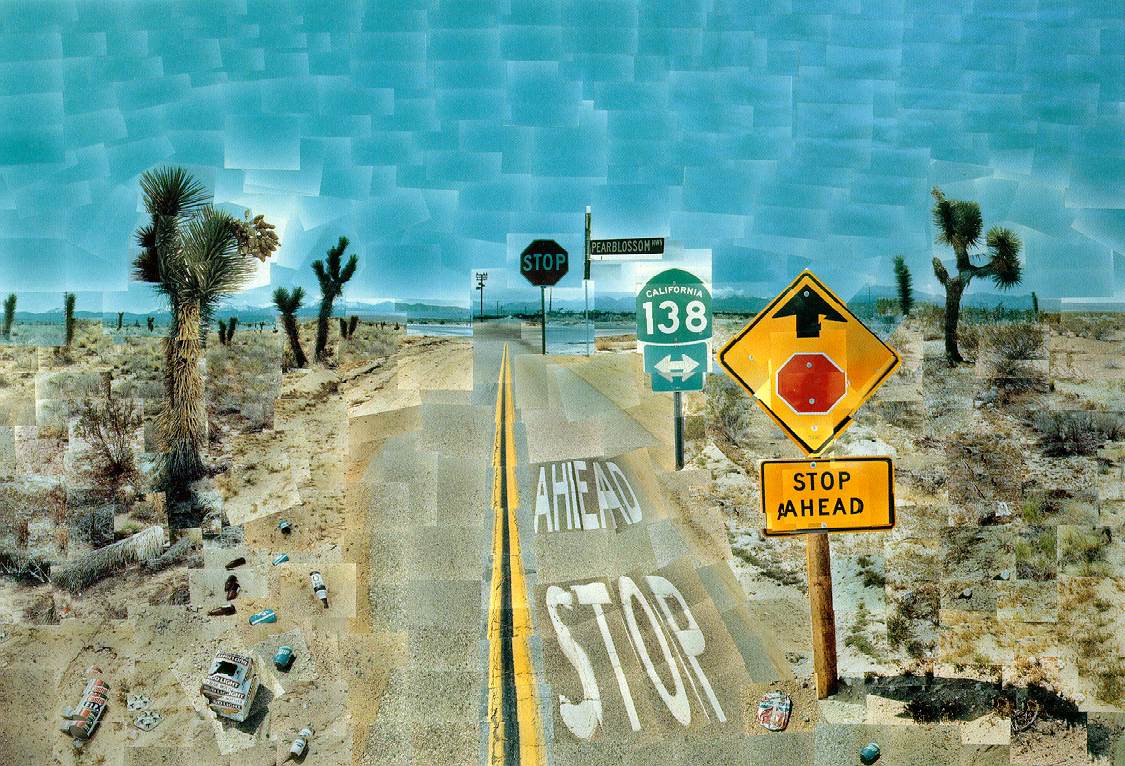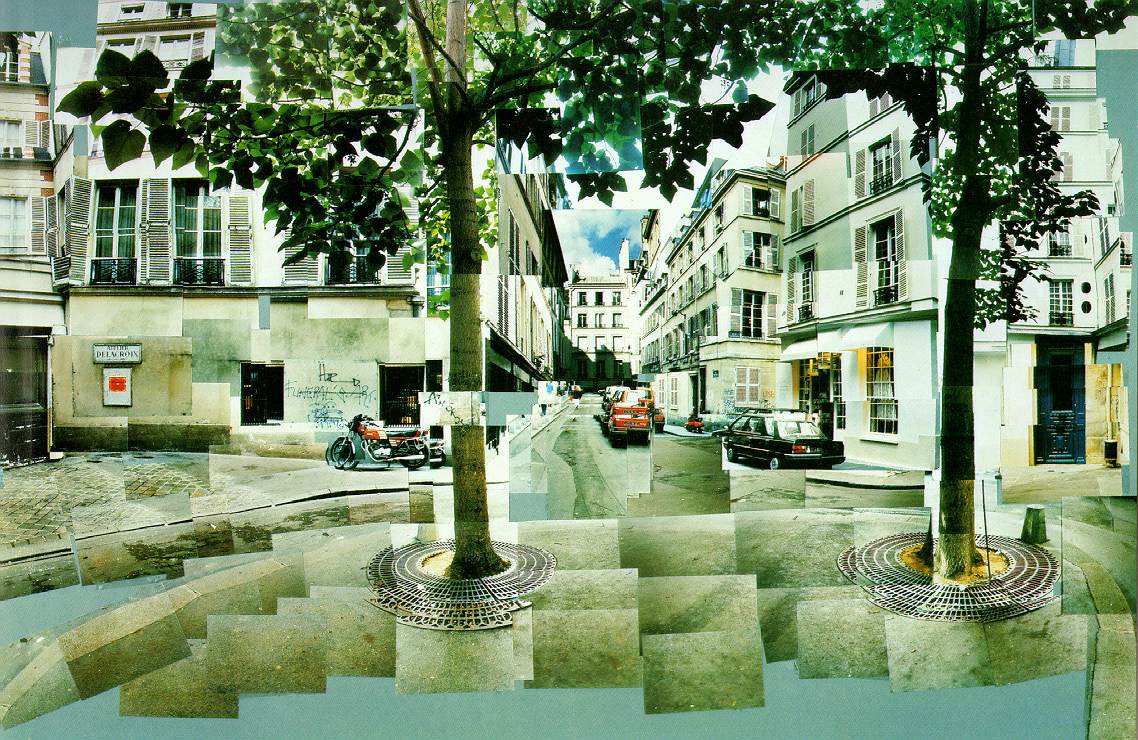http://www.hockneypictures.com/

1986 (190 Kb); Photographic collage, 198 x 282 cm (78 x 111 in); Collection the artist

1985 (220 Kb); Photographic collage, 88.9 x 80 cm (35 x 31 1/2 in); Collection of the artist
------------------------------------------------------------------------------
TIMELINE: Pop Art
--------------------------------------------------------------------------------
Hockney, David (1937- ). British painter, draughtsman, printmaker, photographer, and designer. After a brilliant prize-winning career as a student at the Royal College of Art, Hockney had achieved international success by the time he was in his mid-20s, and has since consolidated his position as by far the best-known British artist of his generation. His phenomenal success has been based not only on the flair, wit, and versatility of his work, but also on his colorful personality, which has made him a recognizable figure even to people not particularly interested in art: a film about him entitled A Bigger Splash (1974) enjoyed considerable popularity in the commercial cinema.
His early paintings, often almost jokey in mood, gained him a reputation of leading Pop artist, although he himself rejected the label. In the late 1960s he turned to a weightier, more traditionally representational manner, in which he has painted some striking portraits (Mr and Mrs Clark and Percy, Tate, London, 1970-01). He has spent much of his time in the USA, and the Californian swimming pool has been one of his favourite themes (A Bigger Splash, Tate, 1967). Often his work has a strong homo-erotic content. Hockney is a brilliant draughtsman and has been as outstanding as a graphic artist as he has as a painter, his work in this field including etched illustrations to Cavafy's Poems (1967) and Six Fairy Tales of the Brothers Grimm (1969). In the 1970s he came to the fore also as a stage designer, notably with his set and costume designs for Stravinsky's The Rake's Progress and Mozart's The Magic Flute produced at Glyndebourne in 1975 and 1978 respectively. The broader style demanded by stage design is reflected in his most recent easel paintings. In the 1980s he has experimented much with photography, producing, for example, photographic collages and -- since 1986 -- prints created on photocopiers. Hockney is a perceptive commentator on art and in 1976 published a book on his own work, David Hockney by David Hockney
Technically, it is true to say that the Pop movement started with Richard Hamilton and David Hockney in England. Hockney's early work made superb use of the popular magazine-style images on which much of Pop Art is based. However, when Hockney moved to California in the 1960s, he responded with such artistic depth to the sea, sun, sky, young men, and luxury that his art took on a wholly new, increasingly naturalistic dimension. Though one might consider A Bigger Splash a simplistic rather than a simplified view of the world, it nevertheless creates a delightful interplay between the stolid pink verticals of a Los Angeles setting and the exuberance of spray as the unseen diver enters the pool. There is no visible human presence here, just that lonely, empty chair and a bare, almost frozen world. Yet that wild white splash can only come from another human, and a great deal of Hockney's psyche is involved in the mix of lucidity and confusion of this picture.

1967; Acrylic on canvas, 242.5 x 243.9 cm (95 1/2 x 96 in)
A Bigger Splash was painted in Califomia in the early summer of 1967. It is a record of a typical warm, sunny, cloudless day; from the position of the shadows cast by the eaves of the building and the chair, it appears to be midday when the sun is highest in the sky and the heat is most intense. The solitary figure, who has just dived into the pool, has been deliberately overwhelmed by the strength and composure of the rest of the composition. The hidden depths of this picture take longer to assimilate than its immediate joyful and decorative appeal...
The only section to break the balanced and cool abstraction of the strong horizontals and verticals is the diagonally placed diving board and the splash. The spindly diagonal legs of the folding chair in the distance echo the thrust of the actual splash, while the point at which the swimmer entered the pool, creating the splash, is emphasized and delineated above by an odd thickening of the narrow white line along the roof.
Hockney recalls that he began the painting by drawing the basic lines of the composition; it is unclear whether he means that he actually drew by graphic means upon the canvas or that he mapped out the lines and the areas they enclose by using strips of self-adhesive masking tape. Certainly there is no evidence of a preliminary underdrawing. The painting is executed in Hockney's favorite Liquitex on white cotton duck canvas. Except for the splash, the paint surface is very flat.
Hockney applied the paint to the various geometric divisions with a paint roller, and gave each area two or three layers. The colored areas abut one another, and the only parts where there is overpainting, as opposed to successive layering of the same tint of pigment, are those of small details, such as the grass, trees, the reflections in the window, the chair and the splash. These were painted on afterwards with a variety of brushes. Hockney obviously enjoyed working on the splash, '...the splash itself is painted with small brushes and little lines; it took me about two weeks to paint the splash. I loved the idea, first of all, of painting like Leonardo, all his studies of water, swirling things. And I loved the idea of painting this thing that lasts for two seconds; it takes me two weeks to paint this event that lasts for two seconds.'
Not all of the canvas is painted, the areas uncovered being the wide border and the central narrow off-white line which marks the division between the pool edge and the pavement. The tonal relationships between the painted and unpainted sections have altered since 1967 because the original pure whiteness of the cotton duck canvas has slightly dulled with age.
'Art Link' 카테고리의 다른 글
| Journal Hz (0) | 2007.10.03 |
|---|---|
| Random Magazine (0) | 2007.10.03 |
| PingMag (0) | 2007.10.03 |
| Warm Up Party , 2007 (0) | 2007.10.02 |
| http://www.robgonsalves.com/ (0) | 2007.10.01 |



